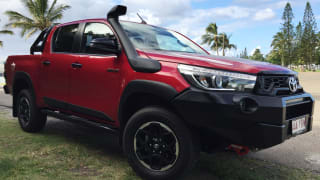
Toyota HiLux 2019 review: Rugged X
Australia has been waiting a whole decade for a new HiLux, but does the all-new model live up to the legend?
Browse over 9,000 car reviews
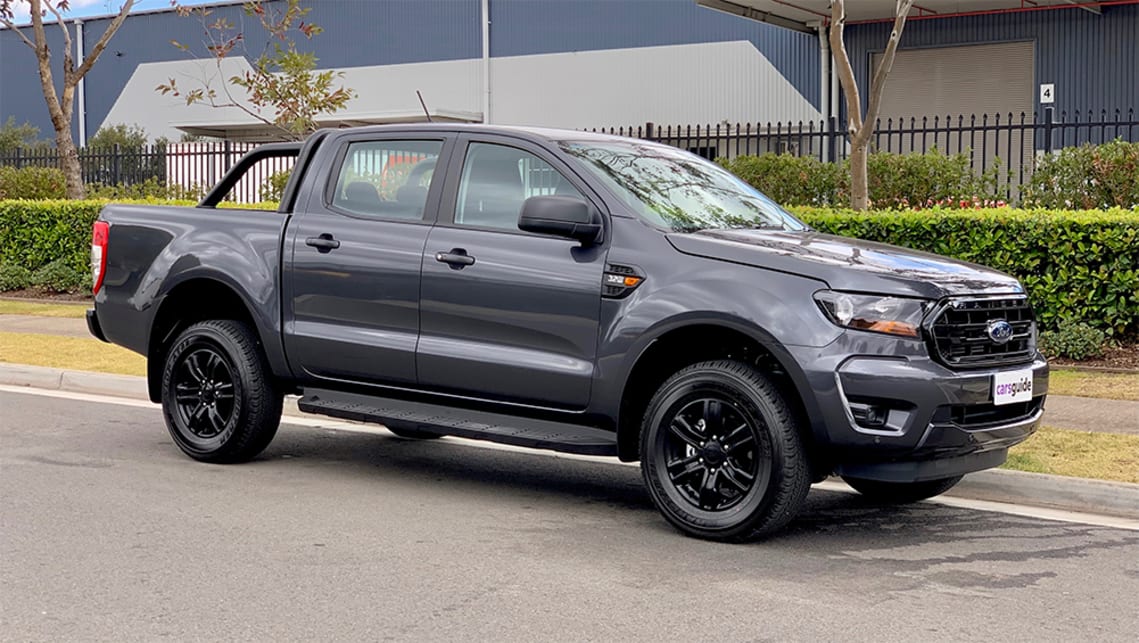
If you want a Ford Ranger, there’s a good chance you wish you could get your hands on a Wildtrak or Raptor version.
But what if you can’t afford to splurge that much? Well, there’s a new Ranger Sport variant to appeal to you, and it takes the notion of a tough looking truck and combines it with a more affordable price.
It’s based on the XLS variant, with a few extras inside and out. Here’s what it’s like.
| Ford Ranger 2020: Sport (4X4) | |
|---|---|
| Safety rating | |
| Engine Type | 3.2L turbo |
| Fuel Type | Diesel |
| Fuel Efficiency | 8.9L/100km |
| Seating | 5 seats |
| Price from | No recent listings |
The Ranger XLS is one of the more work-focused looking versions of the Ranger, but the Sport variant makes it a more, dare I say it, “sporty”.
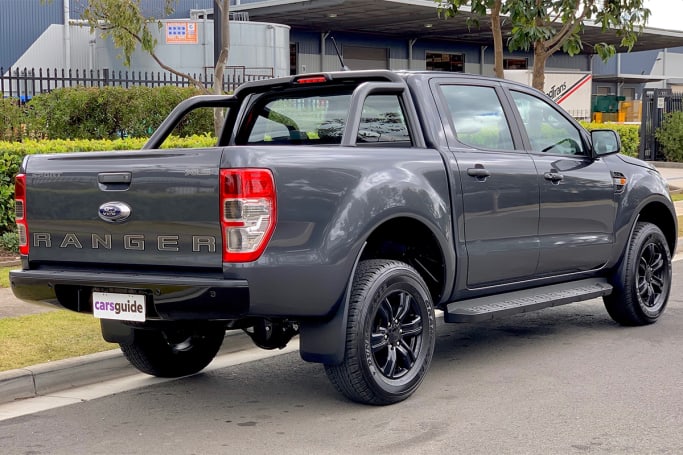
It adds a dark finish to the grille, 17-inch black alloy wheels, blackened mirror caps, door handles and a black rear bumper. It also gets a black sports bar, side steps, tub liner and Sport decal. So, essentially the Sport addresses all the, er, less likeable points of the XLS (small alloy wheels, no side steps, thin rear bumper, and the back window protector) and almost XLT-ifies them.
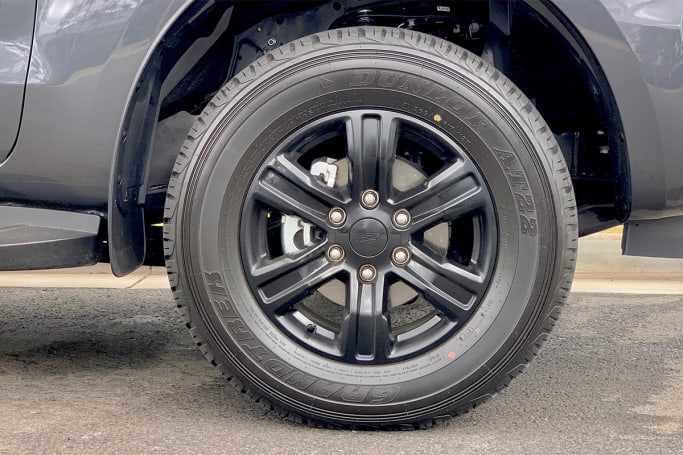
The Sport model is available in True Red, Meteor Grey (as you see here), Arctic White, Shadow Black and Aluminium Metallic paint finishes.
Dual-cab utes are pretty close to one another when it comes to interior practicality.
In the Ranger there are big cup holders, loose item storage in front of the gear shifter as well as a decent centre console bin, door pockets with bottle holders in all four doors, and one rear map pocket. No dash-mount cup holders or a dash-top storage caddy like some other utes, though.

The rear seat base can be folded up to allow for additional secure dry storage, and there are dual ISOFIX child seat anchor points for the outboard seats, and two top-tether points there, too - no middle seat baby point, though.
You can fit three adults across the back row if you need to - the Ranger has impressive legroom, toe space and headroom, but isn’t as broad across the back seat as a VW Amarok so those with broad shoulders may find it a squeeze.
What about the tray, then?
The tub floor has a length of 1549mm, and it’s 1560mm wide with 1139mm between the wheel-arches - too narrow for an Aussie pallet to fit (1165mm square). The tub depth is 511mm to the rail, and over the XLS the Sport model gets a hard-wearing tub liner. There are four tie-down hooks in the corners of the tub - depending on the load, they can be inconveniently placed.
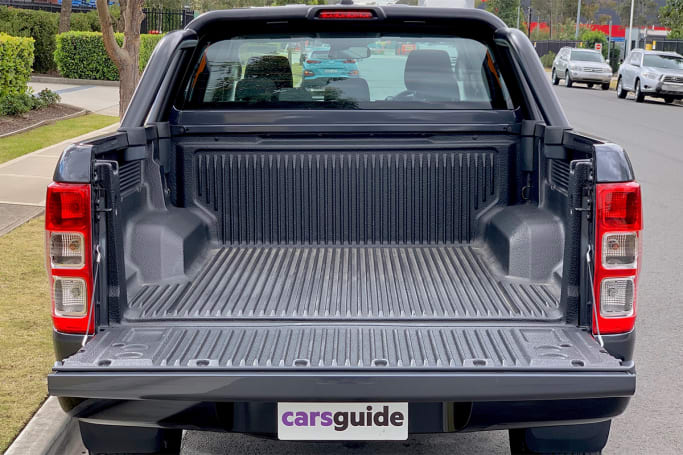
Unlike the XLT, the Sport model retains the higher-set rear step bumper, which requires more leg extension than the rear step fitted to higher grade models.
The Sport model is based on the work-ready XLS grade, but brings some changes to bridge to gap to the XLT. Ford claims the Sport adds $6000 worth of extras for $3000.
Being based on the XLS, the Sport is only available as a dual-cab 4x4 model, with the choice of a six-speed manual transmission ($52,490 plus on-road costs) or six-speed automatic as tested here ($55,140).
Ford is, however, undercutting its own list pricing by a decent margin. The Sport manual is listed at $47,490 drive-away while the auto is $49,990 drive-away.
Unlike the XLS in which you have to option the Sync3 Pack for $1950, the Sport sees the standard fitment of the impressive 8.0-inch media screen with in-built sat nav, Apple CarPlay and Android Auto, as well as the dual 4.2-inch colour instrument screens, dual zone climate control, smart key with push-button start, chrome grille and chrome door handles.
And while you mightn’t be getting leather seats inside, the standard spec includes cloth trim, carpet flooring, Bluetooth phone and audio streaming and USB connectivity. The tub liner is super handy (if slippery), and the additions at the back of the Ranger Sport are definitely an improvement compared to the XLS.
The safety spec of this model is impressive, too - see the safety section below for more info.
This spec of Ranger comes with the 3.2-litre five-cylinder turbo-diesel engine, which remains a stronger-than-most option in the market.
With 147kW of power (at 3000rpm) and 470Nm of torque (from 1750-2500rpm) it pulls harder than many of its rivals, and buyers have the choice of six-speed manual or six-speed automatic.
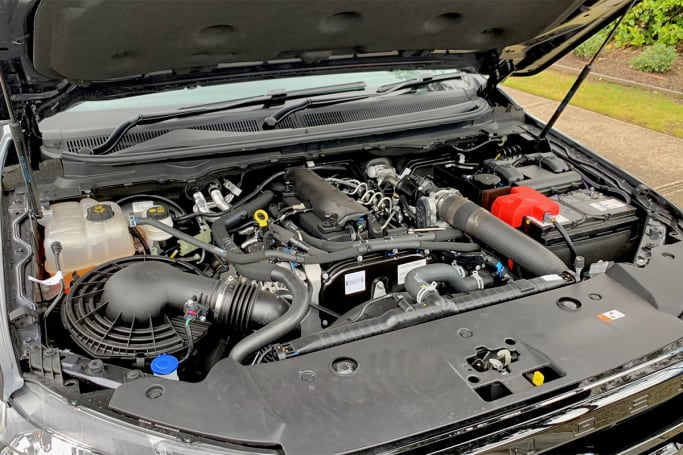
The Ranger’s selectable four-wheel drive system has a low range transfer case (2H, 4H and 4L), and if off-road specs matter to you, here goes: ground clearance mm - 232mm; wading depth mm - 800mm; approach angle - 28 degrees; departure angle - 27 degrees; break-over/ramp-over angle - 24 degrees.
Towing capacity is pegged at 750kg for an unbraked trailer, and 3500kg for a braked trailer. That’s as good as you can get in this segment.
Fuel consumption for the XLS automatic is claimed at 8.9 litres per 100 kilometres. On test, we saw 10.0L/100km - but we didn’t do any hard work with our Ranger Sport, nor did we take it off road. In fact, it was mainly driven around town and on the highway, but that actual fuel use number is pretty good for this class of ute.
Fuel tank capacity is 80 litres, meaning a theoretical range of about 730km.
The Ranger is a great base to work from, but does the Sport add any sportiness to the drive experience? No. Not really.
Well, aside from a firmer feeling ride, because it has larger 17-inch wheels and all terrain tyres than the XLS (Dunlop Grandtrek AT22 in 265/65/17 size).
Fortuitously, I had stepped out of the Ranger XLS and into the Sport, and you might find the step up in wheel size a detriment to the ride comfort - I certainly felt more of the lumps and bumps in the road surface below, and I drove over the same roads in both vehicles.
In the XLS the suspension is quite supple, but in this grade there’s a bit more jostle at the rear axle when unladen, and sharp edges can prove shunty.
But it retains the excellent steering the Ranger is known for - it’s light and accurate, if lacking a bit of feel, but the weighting of the steering and its speedy response times makes a big ute (with a big turning circle of 12.7m) feel a lot smaller, especially when you’re trying to park it. That steering also tracks well on the highway - it’s easy to judge and quick to respond.
The engine and transmission mostly work well, though the engine can be noisy at times and there can be some turbo lag from a standstill. The rolling acceleration response is great, and it never feels short of shove.
For this test we didn’t put weight in the tray, but you can read my 2020 Ford Ranger XLS review to see how it fared with 750kg in the tray. Based on that test, we’d think the ride would still be a touch firm over sharp edges in the Sport model.
If you do plan to put your Ranger Sport to work, some of the specs you want to know are as follows: gross vehicle mass (GVM) - 3200kg; payload of this variant is 998kg for the auto and the kerb weight is 2202kg. (For the manual version, there’s a 1016kg payload and 2184kg kerb weight). Keep in mind that the gross combination mass (GCM) is 6000kg, so if you plan to tow at maximum, keep in mind your payload will be compromised.
Basic Warranty
5 years / unlimited km warranty
ANCAP Safety Rating

In 2019 Ford Australia rolled out some vital safety gear to the Ranger line-up, including auto emergency braking (AEB) with pedestrian detection, lane keeping assist, driver attention alert, traffic sign recognition and auto high-beam lights.
Because it’s based on the XLS, the Sport still misses out on adaptive cruise control, and no Ranger has blind spot monitoring or rear cross-traffic alert yet, either. But at this price point, the Sport is well equipped for safety tech - better than most of its rivals, in fact.
The Ranger scored a five star ANCAP crash test rating in 2015 - based on that less stringent criteria - but the updated standard gear list meets 2019 standard.
There are dual ISOFIX child seat anchor points and outboard top-tether points, but no centre top-tether.
Ford backs its vehicles with a five-year/unlimited kilometre warranty - as good as most of the utes out there, but not setting any benchmarks.
Capped price servicing has intervals set every 12 months/15,000km, and that plan covers the life of the vehicle.
Based on the first five years/75,000km the average service cost is $494 before additional consumables. Not what you’d call cheap, though not as pricey as some of the other utes out there.
The Ford Ranger Sport takes the impressive work-focused XLS model and makes it more appealing to those who want the more work-and-play focused vehicle at a lower price.
It will definitely appeal to those who can’t quite stretch the extra few grand to the XLT, or the bigger jump to the Wildtrak or Raptor.
| Vehicle | Specs | Price* | |
|---|---|---|---|
| XL 2.2 LOW Rider (4X2) | 2.2L, Diesel, 6 SP MAN | No recent listings | 2020 Ford Ranger 2020 XL 2.2 LOW Rider (4X2) Pricing and Specs |
| XL 3.2 (4X4) | 3.2L, Diesel, 6 SP AUTO | No recent listings | 2020 Ford Ranger 2020 XL 3.2 (4X4) Pricing and Specs |
| XL 2.2 Hi-Rider (4x2) | 2.2L, Diesel, 6 SP AUTO | No recent listings | 2020 Ford Ranger 2020 XL 2.2 Hi-Rider (4x2) Pricing and Specs |
| XL 2.2 (4X4) | 2.2L, Diesel, 6 SP AUTO | No recent listings | 2020 Ford Ranger 2020 XL 2.2 (4X4) Pricing and Specs |
| Design | 8 |
|---|---|
| Practicality | 8 |
| Price and features | 9 |
| Under the bonnet | 8 |
| Efficiency | 8 |
| Driving | 8 |
| Safety | 9 |
| Ownership | 7 |
$21,990
Lowest price, based on 1023 car listings in the last 6 months